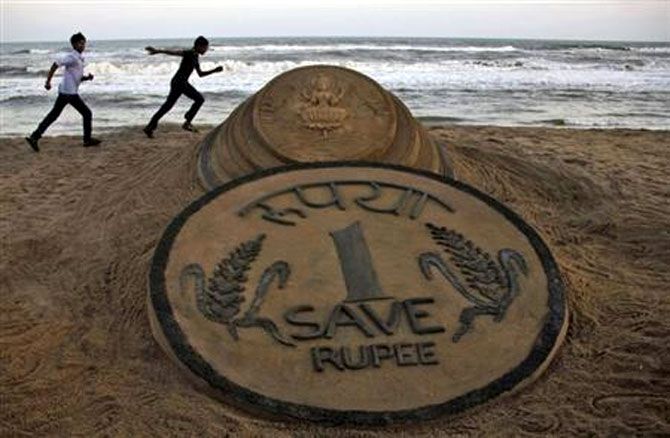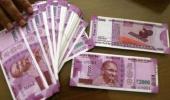A weaker rupee could aid corporate earnings through its positive impact on export intensive sectors such as information technology services, pharmaceuticals and commodity producers such as metal and mining, and oil and gas companies.

Dalal Street expects more upsides from the depreciation in the rupee against the dollar than downsides.
Edelweiss Securities, for example, expects a weaker rupee to aid corporate earnings through its positive impact on export intensive sectors such as information technology services, pharmaceuticals and commodity producers such as metal and mining, and oil and gas companies.
'Ten per cent depreciation in rupee boosts Nifty50 companies' combined earnings per share (EPS) by 3-4 per cent (ceteris paribus).
'However, this has not played out perfectly historically,' a recent report by Prateek Parekh and Aditya Narain of Edelweiss Securities said.
Rupee is down 10 per cent on year-to-date basis against 6 per cent appreciation in the last calendar year.
They say that while currency depreciation in 2013, following the tapering of quantitative easing by US Federal Reserve provided a boost to IT, pharma and commodity companies' earnings; a steady fall in rupee between 2014 and 2016 led to deflation and provided very little benefit to these companies.
According to them, though IT and pharma companies are likely to benefit, full gains of ruppe depreciation may not accrue to them. IT and pharma companies together have 16.4 per cent weightage in Nifty50 index.
Commodity producers, such as Hindalco Industries, Vedanta, Coal India and Reliance Industries, account for another 17 per cent of the index.
Others, however, discount the tailwind effect of currency depreciation, given poor show by export sectors in the past few years despite a weaker currency.
"There was a steady depreciation in rupee between 2014 and 2016, but our exports struggled during the period.
"In contrast, exports picked up pace last year due to better global demand, despite currency appreciation," said G Chokkalingam, founder and MD, Equinomics Research and Advisory Services.
India's non-oil merchandise exports declined to $244 billion in FY17 from $251 billion in FY14 despite the rupee falling to Rs 65 against a dollar in FY17 from Rs 60 in FY14.
Services exports during the period moved from Rs 157 billion to Rs 161 billion.
Analysts also worry about the adverse impact of currency depreciation on companies with foreign currency debt or those who rely on imported raw materials such as coal, chemicals and metal products.
"Currency depreciation means costlier inputs for domestic manufacturers, which is likely to hit corporate margins unless companies find a way to pass it on to consumers.
"Full pass through looks tough in current environment so expect a decline in corporate margins in the forthcoming quarters," said Dhananjay Sinha, head, research, Emkay Global Financial Services.
According to analysts, coming months would see more hawkish monetary and fiscal policy to reinforce inflation fighting credibility with rupee fluctuating in both directions.
For example, analysts with Axis Capital said that almost 53 per cent of forex liabilities of BSE500 companies have a natural hedge in the form of forex revenues.
"But the energy and infrastructure firms are exposed with the latter more sensitive due to low interest cover.
"Expect hedging costs and rupee borrowing for these firms to rise," an analyst with Axis Capital said.
Axis Capital said that since FY18 balance sheets were not yet available for all BSE500 companies, it took into account the FY17 liabilities position of these companies.
There were 125 companies with forex borrowings totaling $45 billion at the end of FY17, but total forex earnings from these companies were $51 billion, which shows that at a macro-level there was a natural hedge.
However, this can be misleading due to mismatch of liabilities and earnings at sector level.
While the good news is that oil, metals, cement and conglomerates that collectively make up 53 per cent of forex liabilities have a natural hedge in the form of sufficient forex earnings, the energy and infrastructure firms do not have a natural hedge and could see servicing costs rise due to rupee depreciation.
In the case of energy, there is sufficient interest cover, but infrastructure looks vulnerable, Axis Capital said.
Some of these companies would try and switch these exposures to rupee borrowings, it added.











